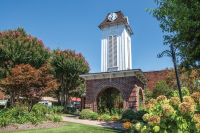Nature shines in Morgan poetry collection
To see a world in a grain of sand,
And a heaven in a wild flower,
Hold infinity in the palm of your hand,
And eternity in an hour.
— “Auguries of Innocence” by William Blake
Related Items
The stanza above, from William Blake’s “Auguries of Innocence” serves as an apt introduction to Robert Morgan’s latest collection of poetry. Here, the reader will find a catalog of vivid images from the natural world: a spider’s web spangled with dew drops; mountain pools pierced by sun beams; a wind-blown thistle and the husk of a jar fly — all transformed by Morgan’s elegant words — words which have the power to render these images “numinous” (possessing a religious or spiritual quality).
In conjunction with Morgan’s skill in capturing vibrant images is his ability to describe those images with magical language. For example, the title of this collection, Terroir, is a word (French in origin) used to denote the special characteristics that geography, geology and climate bestow upon crops and/or produce. Just as the quality of a vintage wine may be determined by the combined effects of a particular region’s rivers, the mineral content of the soil and the length of the growing season, Morgan suggests a parallel in the natural world of Appalachia. In effect, the inhabitants of the coves and ridges of the Southern Highlands are what they are because of the same factors. We (and all living things) are molded and shaped by the same forces that might render/produce something original ... a rare wine with its unique taste or a mountain family, surviving against all odds and steeped in tradition.
Terroir contains a number of recurring themes: rituals, folk beliefs, superstitions and the subtle and orderly design of the natural world.
“October Crossing” celebrates the annual orange and black, woolly worm migration which, in mountain folklore will determine how hard the winter will be. However, in Morgan’s imaginative description, this events merges with classical mythology. The woolly worms migration must cross a highway “like a hard Styx or Jordan” to reach the refuge of the woods. In “Apple Howling,” there is a comparison of the Anglo-Saxon “come forth” ritual in apple orchards (beseeching the trees to produce a generous crop), to the “come, butter, come” incantations that my own grandmother chanted to transform clabbered milk to butter. “Singing to the Corn” recounts yet another ritual to encourage fertility and “Immune” celebrates an old superstition about going barefoot in the first snowfall as a means of preventing winter ailments.
Beneath all of these poems, like a quiet, but ever-present stream, is a series of affirmative verses regarding Nature’s “silent design.” “Loaves and Fishes” celebrates the slow decay of a deer on the highway, noting the process by which every bit of flesh “is sorted, hauled/ away by scavenging coyotes,/ by maggots, worms, bacteria, /each bite sent to its proper place/ to feed the needy multitudes.” “Translation” finds a striking example of rebirth in the way that trees die “and lean into the arms/ of neighbors” where they gradually disintegrate and “... eed the the roots/ of soaring youth.”
There are also frequent allusions to Nature’s tendency to “mimic” cosmic design. For example, the sprouts of potatoes struggling toward the light in “Homesickness” resembles genetic memory struggling “across the gulf of history.” In another poem, In “Country of the Sun,” Morgan finds a poignant parallel in the struggles of a neighbor stricken with an eye cancer who moves down a road in the sunlight of a spring day with the same yearning towards the light. In “The Big One,” the explosion of seeds from a winter thistle resembles that outward rush of matter that created the universe. Again, in “Lone Eagle,” the fall of snow flakes in a pine forest suggests “a ticker tape parade” witnessed by “snow bird, mouse and solo wren.” The spiraling flight of sulfur butterflies in “Convocation,” suggest the “swing and rise” of planets and “far quasar.”
Many of Morgan’s most affecting poems describe an embattled natural world where corrupting forces contaminate beauty. “Brownfield” describes a field filled with “industrial swill,” tatters of asbestos and rusting nails, styrofoam, grease and garbage bags; yet even here, Nature struggles stubbornly to reassert itself with a thriving patch of ironweed. In “Expulsion” Morgan compares humanity’s withdrawal from polluted tracts of land to the loss of Eden. We are forced to leave because our eyes are “swollen red” by a corrupting dust. Yet, even here, the stubborn persistence of “Poison Oak” demonstrates Nature’s survival instinct “that will cross a meadow” to claim a spot at the base of a tree.
My favorite poem in this collection is “Go Gentle,” a reasoned rebuff to the poet, Dylan Thomas who is remembered for his advice to the elderly: “rage against the dying of the light.” For Morgan, such a recommendation seems a bit melodramaic. After witnessing the death of relatives and friends, Morgan concludes that both those who watch and those who die “will plead for nothing but the right/ and gentle passage of the night.” There seems little point in delivering a death rant.
This is a gratifying collection. Although Robert Morgan is attracting national attention for his novels and historic biographies, I feel that his greatest strength lies in his poetry.
Terroir by Robert Morgan. Penguin Books, 2011. 95 pages.









